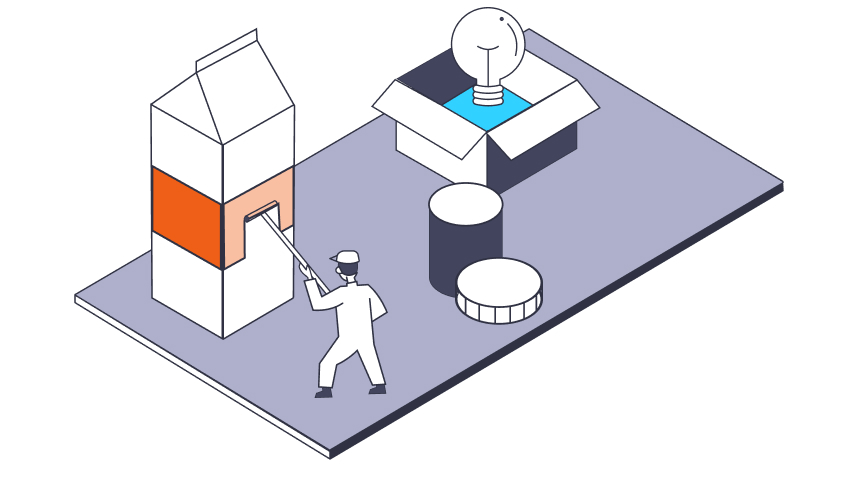Omnichannel guessing games
The market has changed radically over the past few years, making traditional measurement tools and practices obsolete and leaving many CPG manufacturers and retailers believing they have no choice but to guess or extrapolate. Online channels are drawing an influx of new shoppers—22 million of them in 2020 alone—and new fulfillment methods like click-and-collect make it difficult to differentiate between e-commerce and brick-and-mortar sales. Omnichannel shopping behavior is shifting in unpredictable ways. Once-reliable data sets now only provide half the picture, leaving retailers and CPG manufacturers to guess at the rest.
So, how do we eliminate the guesswork and get a complete, accurate view of the omnichannel marketplace? The guessing games end at the intersection of omnisales and omnishopper data. Omnisales and omnishopper data offers a way to analyze and benchmark sales relative to competitors across channels, and to understand the consumer behavior that drives those sales. Plus, it provides that insight in a digestible, actionable format from reliable sources, backed by verifiable truth sets.
One tool, one number, one truth
Because the CPG market is fragmented by channel, the tools used to measure it are equally disparate. Traditional brick-and-mortar sales can be captured by well-accepted methods that have been employed for years, including POS data, retailer reporting, and/or internal data. Online sales have proved trickier to measure, with limited visibility into specific e-commerce platform performance.
By combining the two and introducing new complications like cross-channel fulfillment (click-and-collect and delivery), omnichannel sales are perhaps the most difficult to capture accurately. Amid this uncertainty, too many estimation-based solutions have emerged, each claiming to provide a measure of the omnichannel market that’s “good enough.”
But good enough won’t cut it. The CPG retail landscape is now an omnichannel world, which in turn requires a recognizable source of truth; a set of numbers which trading partners from manufacturers to retailers to analysts all agree on. Omnisales and omnishopper data, together, offer that source of truth.
A seamless data canvas
Many CPG manufacturers and retailers are trying to find that source of truth on their own, and they’re finding that it’s an arduous process. Some dedicate entire teams to stitching together disparate data sources into a patchwork solution. This improvised approach can work, but time and analytics talent are finite resources.
For a CPG manufacturer to understand its share of omnichannel sales in a given market, it would have to compare its own sales to all of its competitors across all retailers in the market, and then analyze what percentage of those sales are attributable to online and offline channels.
Because not all retailers will be willing to share competitor sales data, that manufacturer would have to source third-party data sets to get a complete picture. Since even fewer retailers break out their sales by channel, or account for duplicate transaction measurement from click-and-collect sales, their analysts must comb through those figures to get a nuanced understanding of their performance.
All of that is just to understand omnichannel share. It has not even begun to match up the consumer behavior that is driving that share so that they can fine-tune their sales and marketing strategies.
Performing this analysis across markets and categories requires significant resources. In this way, an omnichannel data set that eliminates the need to process disparate data sources contributes directly to the bottom line.
Telling a unified story
A reliable omnichannel data set doesn’t just save CPG manufacturers or retailers time and money. It also facilitates collaboration between the two by providing a shared data foundation upon which to work. When retailers and CPG manufacturers can agree on where sales changes are coming from—what channels, as well as which brands and products are driving it—then they can work together to execute strategies to manage it. When both category managers and buyers are able to track shopper and share leakage accurately, they can take steps together to combat it.
For CPG manufacturers, being able to provide reliable omnichannel data makes them more valuable to their retail partners—which means that furnishing accurate insights to retailers can be a path to category leadership and greater influence over in-store and online tactics, like promotional support.

One number, one truth
Could you be using your omnichannel data better?
Developing a cohesive strategy
While there are tactical advantages to having access to omnichannel data, its real value is in informing winning strategies. With a single source of omnichannel truth—and with less time spent crunching numbers to get it—CPG manufacturers and retailers can develop more actionable, confident growth and marketing strategies.
For CPG manufacturers with narrow margins, the need to base strategic decisions on the most accurate, granular data possible is even more pronounced. Losing even a fraction of a percent of omnichannel share can have a significant impact on sales volume, much more magnified than a similar share loss would be in a brick-and-mortar-dominated environment.
For retailers, granular omnichannel data is particularly important for their fulfillment strategies. Understanding how competing retailers’ fulfillment methods are performing relative to their own can help them determine where to put their resources.
A marriage made for the omnichannel marketplace
Not all omnichannel data is created equal. Only with a solution underpinned by both omnishopper and omnisales data can retailers and CPG manufacturers truly eliminate blind spots.
Omnisales describes what happened—where sales grew or declined, and for whom. Basing online sales measurement on consumer panel reporting, and aligning that with traditional retail cooperation through RMS reconciliation and verification yields accurate omnisales data.
Omnishopper answers why—which shopper decisions drove sales, and where and to whom they flowed. Omnishopper data provides a clear picture of which competitors are the source of gains and losses due to switching, and to what degree consumers substitute competing brands or shop the same items at competing retailers. This data will also show if shoppers are new to the category or recently stopped purchasing from the category altogether, affecting sales volume.
Together, they form an omnichannel truth set that retailers and CPG manufacturers can rely upon to make good decisions, develop winning strategies, and drive growth.



